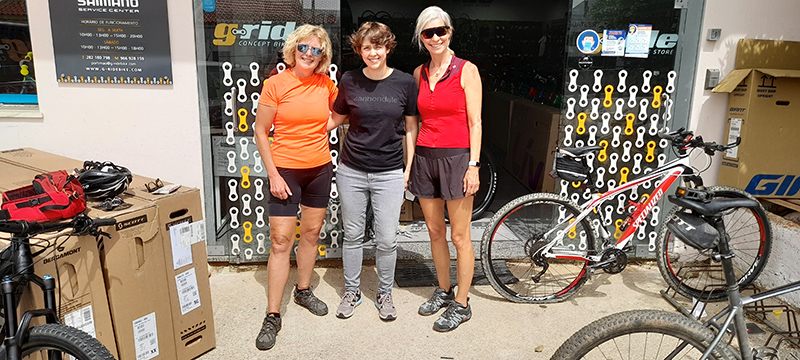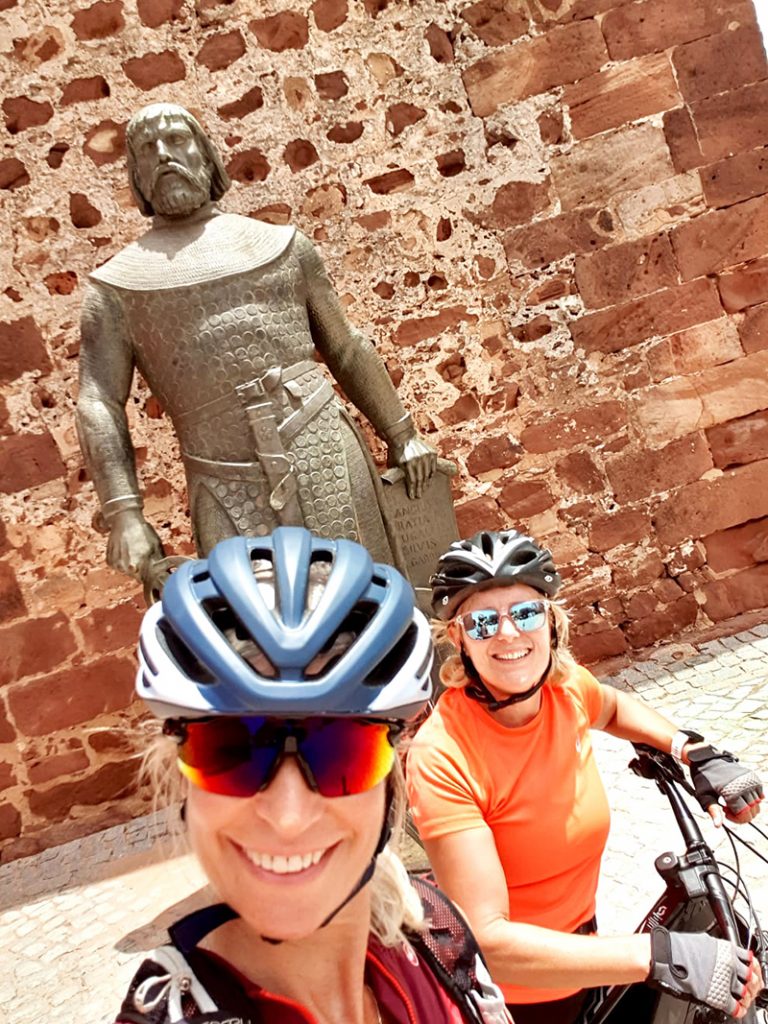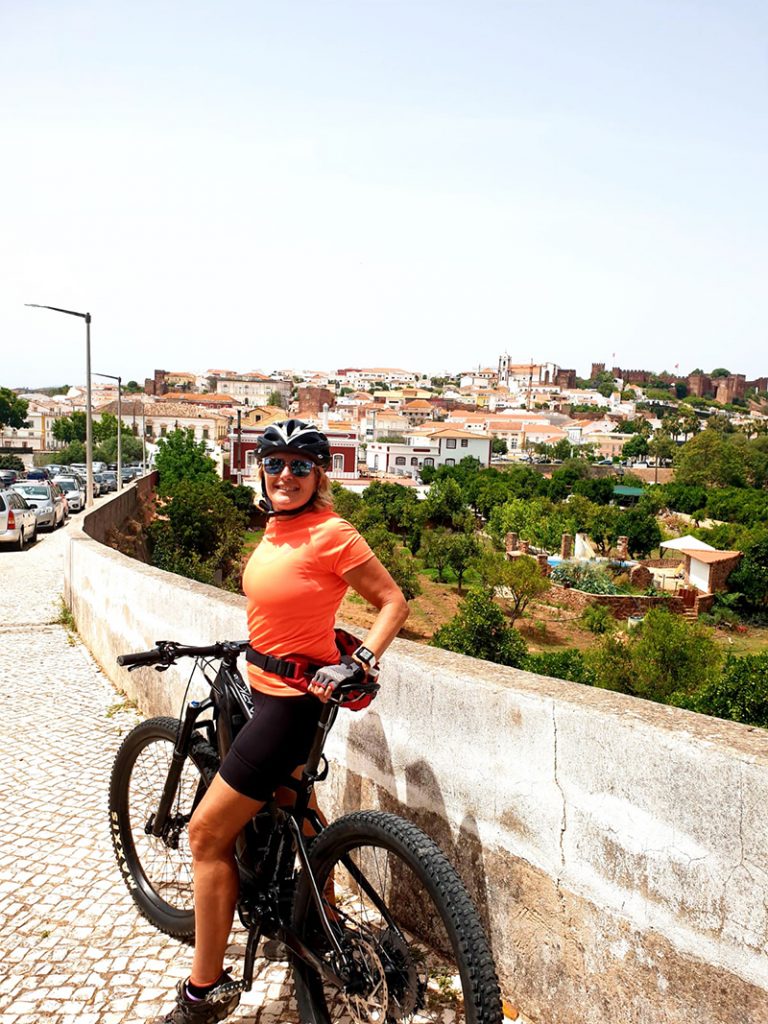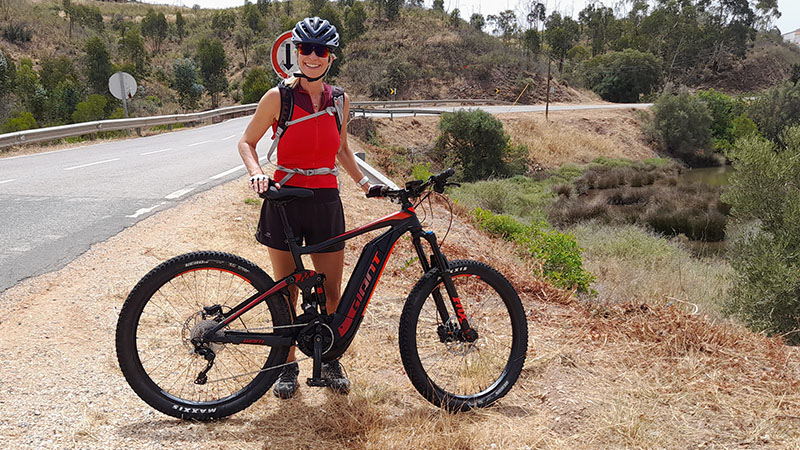Hi, Gilly here, buzzing after a great day out on an eMBT (electric mountain bike)!
One of my riding groups is mixed regular mountain bikes and eMBTs, and it works really well for us. I’m in the traditionalist camp and we regularly joke with the e-bikers about the assistance they get on the climbs. They are quick to point out that their advantage is also a disadvantage as they are on heavier bikes.
We all ride our bike of choice and enjoy great rides – to us, it’s not which type of bike is right; it is all about the bike that’s right for you.
I get a huge buzz out of the hard hills, the burn on the climb and the adrenaline on the downhill. However, I was still mildly inquisitive about e-bikes, so when Ana from G-Ride Concept Bike Store in Portimão offered the opportunity to take a couple of their eMBTs out for a spin, I was keen to try.
With my biking pal Nik, we took off from Portimão around the back lanes into Silves and cruised around the cobbled streets. We found a trail from the Roman bridge to Fontes de Estombar, with a single track, some rougher terrain, a nice bumpy downhill trail (and climb back-up, fast, with the power on ‘Turbo’ when we stirred some dogs from their afternoon nap). We ended the ride through the centre of Portimão.

Gilly, Ana and Nikki
The bikes were really comfortable on the roads with little effort and the motor assisting at the lowest ‘Eco’ level. We maintained a comfy 25km/hr and got to where we were heading in good time. Off-road, the experience was similar. I enjoyed being able to switch quickly between the levels to gain assistance up over rocks and on climbs (because I could!) and the wide tyres made the bike feel very stable on the rougher sections and the downhill. I did drop my chain and found the bike more difficult to flip than my regular bike because of the weight, but it wasn’t a huge issue. All in, I really liked the bikes and we had a great day, thanks Ana!
Would I swap to eMTB right now? Probably not. As mad as it sounds, I enjoy the burn. But, if things change for me when my dodgy knees say enough is enough, then I would have no hesitation in making the move; and I would definitely look to hire eMBTs for a touring holiday, where I would enjoy the benefits of longer, less strenuous cycling days and being able to cover greater distances faster.
If this has made you think an eMBT could be right for you, you want to find out more about them or have an e-bike that would benefit from a service, I have dropped a link to G-Ride below. If you do make the swap or already enjoy the benefits of eMBT, then as always, it would be great to hear from you at bikinginthealgarve@gmail.com

Nikki and Gilly in Silves

Gilly riding through Silves
What is an eMBT?
It is similar to a regular mountain bike, with the same mechanical elements and components. But it also has an electrical drive system, which includes a battery, motor, display, controller and wiring.
The battery powers the motor, which provides assistance as you pedal to help propel the bike forward. No pedalling, no power; that’s not strictly true as most bikes have a walk mode to help with pushing your bike over obstacles!
The motor has various levels of assistance and it’s up to the rider to select what they need, which might depend on the terrain, the incline, headwinds or energy levels.
Considerations usually include the power of the motor, the life of the battery per charge and the lifespan of the components. It’s also worth noting that servicing an eMBT can be more expensive than a regular MBT because of these components and not all bike shops will have access to the equipment and programmes needed to detect or repair system problems.
We were riding a Giant Bike Full E+ 1.5 Pro LTD and a Scott Spark E-710. Both had 500WH batteries (batteries usually vary between 300 and 1000WH, and this can impact on your run time). We were looking at a range circa 100kms on the flat with Eco assistance, which reduced when we climbed and used the Turbo assistance setting, but we were out for a few hours, tried all the settings and came back with lots of power left.
The Giant had a Yamaha motor/system and the Scott a Shimano Steps (in articles I have read, Yamaha, Shimano, Bosch and Brose motors get the best reviews). There was little difference in the riding experience on the different systems, except the torque was slightly higher on the Giant, giving a quicker and bigger boost of assistance when setting off.
The components for the bikes: forks, brakes, chainrings etc., are the same as regular MBT and range from entry-level to a second mortgage!
If you haven’t checked out the new generation of eMBTs, they are super cool; biking magazines and forums suggest sales have really gained momentum in recent years, and the gap between them and traditional MBT in terms of looks and performance is getting much smaller. They are adding something new to the sport, making it more accessible. In the current landscape, they offer an energy-efficient and viable alternative mode of transport.
Will you get a work-out on an eMBT?
Assisted bikes don’t change the act of cycling, they can just make it feel easier or less strenuous on climbs and over tougher terrain. Even with a degree of assistance, riders will still use muscles and burn calories, they will just not exert as much energy over the same ride as a regular MBT rider. Using assistance will take a degree of load from the legs and will require less effort from the heart and lungs, but will still build stamina, burn fat on rides over longer distances and give an upper body work-out.
Asking around, eMBTs seem to be a great option for newbies to the sport or returning cyclists, perhaps with confidence or fitness issues. They are also becoming very popular for experienced cyclists after an injury or during rehab. For riders with time-limited opportunities for exercise or injuries, eMBTs allow them to get out further and faster, to access better trails. They also suit the adrenaline junkies who want to halve their uphills so they can enjoy more downhills.
Points to note
- EU regulations dictate the output of e-bikes is restricted to 25km/hr and riders must be at least 14 years of age
- There is no requirement for the e-bike to be registered, the rider to have a licence, pay road tax or insurance
- E-bikes can be ridden in the same places as regular bikes, including cycle paths
- As with all cycling – ride sensibly, follow the rules of the road and always wear a helmet













